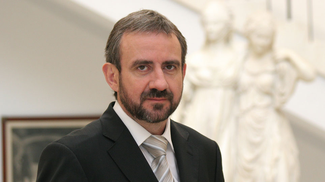Ninth Annual Leon Levy Lecture
This article first appeared in ISAW Newsletter 13, Fall 2015.
supported by The Peter Jay Sharp Foundation
Scythian Elite Burial Mounds in the Eurasian Steppes: New Discoveries for a Deeper Understanding
Hermann Parzinger
President of the Prussian Cultural Heritage Foundation
November 6, 2015
 Prof. Dr. Hermann Parzinger, President of the Prussian Cultural Heritage Foundation
During the first millennium BCE, the cultures in the Eurasian steppe belt went through a deep transformation. From the 8th/7th century BCE on, nomadic tribes emerged throughout that region. We know them as Scythian or Sakas, but it is hardly possible to identify archaeological materials with concrete names of tribes. Significant changes in the economy, in the way of living and fighting, but also in the arts and the social structure, are typical for these early nomadic groups between the river Yenisei in the east and the lower Danube in the west. The social structure of Scythians and other groups in the Eurasian steppe is mainly reflected by their graves, burial mounds, which are called “kurgans.” There are monumental kurgans with rich inventories, including golden objects and imports, and Herodotus wrote about Scythian kings in the steppe to the north of the Black Sea, buried in these huge kurgans. In this region, burial mounds have been excavated since the late 19th century and have yielded many golden objects of an extraordinary technical and artistic quality. Although the grave inventories are quite well known and have been sufficiently investigated, we lack data concerning the structure of these monumental kurgans. Our excavations during the last 20 years in different parts of Russia, from Siberia in the far east to southern Russia in the west, have yielded significant new information and have led to a rather new understanding of the phenomenon of elite kurgans, showing that they are not only burial places of the leading social group, but also places for memory and numerous and rather different ritual practices: elite kurgans are rituals that became architecture.
Prof. Dr. Hermann Parzinger, President of the Prussian Cultural Heritage Foundation
During the first millennium BCE, the cultures in the Eurasian steppe belt went through a deep transformation. From the 8th/7th century BCE on, nomadic tribes emerged throughout that region. We know them as Scythian or Sakas, but it is hardly possible to identify archaeological materials with concrete names of tribes. Significant changes in the economy, in the way of living and fighting, but also in the arts and the social structure, are typical for these early nomadic groups between the river Yenisei in the east and the lower Danube in the west. The social structure of Scythians and other groups in the Eurasian steppe is mainly reflected by their graves, burial mounds, which are called “kurgans.” There are monumental kurgans with rich inventories, including golden objects and imports, and Herodotus wrote about Scythian kings in the steppe to the north of the Black Sea, buried in these huge kurgans. In this region, burial mounds have been excavated since the late 19th century and have yielded many golden objects of an extraordinary technical and artistic quality. Although the grave inventories are quite well known and have been sufficiently investigated, we lack data concerning the structure of these monumental kurgans. Our excavations during the last 20 years in different parts of Russia, from Siberia in the far east to southern Russia in the west, have yielded significant new information and have led to a rather new understanding of the phenomenon of elite kurgans, showing that they are not only burial places of the leading social group, but also places for memory and numerous and rather different ritual practices: elite kurgans are rituals that became architecture.
 Excavation of a Scythian “Ice Mummy”, Summer 2006, Mongolian Altay
About the Speaker: Hermann Parzinger has been President of the Prussian Cultural Heritage Foundation since 2008. From 1990 he was active at the German Archaeological Institute (DAI), from 2003 to 2008 as its president. Today he directs several excavation and research projects and publishes regularly. He has received numerous national and international prizes.
Excavation of a Scythian “Ice Mummy”, Summer 2006, Mongolian Altay
About the Speaker: Hermann Parzinger has been President of the Prussian Cultural Heritage Foundation since 2008. From 1990 he was active at the German Archaeological Institute (DAI), from 2003 to 2008 as its president. Today he directs several excavation and research projects and publishes regularly. He has received numerous national and international prizes.